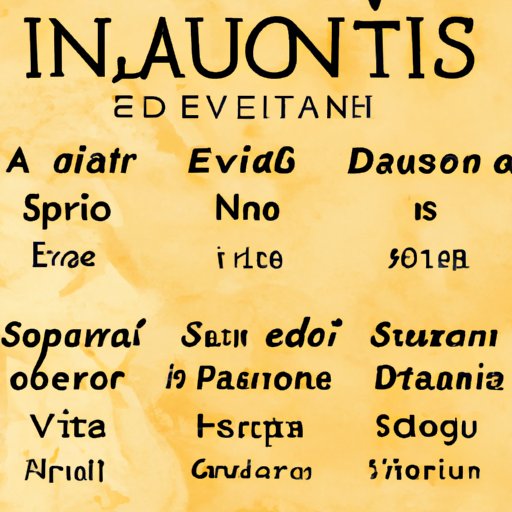Introduction
The origin of Spanish (or Castilian) is an interesting topic to explore. It is one of the most widely spoken languages in the world today and is used in many countries. But what many don’t know is when it was first invented. This article will look at the history of Spanish and trace its roots back to its earliest days.

Historical Overview of When Spanish Was Invented
Spanish is a Romance language that belongs to the Ibero-Romance branch of the Indo-European language family. It is believed to have originated in the area now known as Spain, although some scholars believe it may have also been influenced by languages spoken in other parts of Europe. The earliest written evidence of Spanish dates back to the 9th century, with the earliest recorded use of the language appearing in the 10th century.
The development of Spanish can be traced back to the Latin language, which was brought to the Iberian Peninsula by the Romans in the 2nd century BC. Over time, the Latin spoken on the peninsula evolved into what is now known as Spanish. It is believed that the influence of other languages, such as Arabic and Basque, also played a role in the evolution of Spanish.
Exploring the Origins of Spanish: How and When Did it Come About?
The origins of Spanish are still unclear, but it is generally accepted that the language has its roots in the Latin language brought to the Iberian Peninsula by the Romans. Latin was the language of the Roman Empire and was spread throughout Europe during this period. It is believed that the dialect of Latin spoken on the peninsula eventually evolved into Spanish over time.
The earliest written evidence of Spanish dates back to the 9th century, with the earliest recorded use of the language appearing in the 10th century. This suggests that the language had already begun to take shape before the 10th century, although it is still uncertain exactly when and how it came about.
Tracing the Roots of Spanish: From its Earliest Days to the Present
To better understand the development of Spanish, it is helpful to look at its pre-Roman and Roman influences. Pre-Roman influences can be seen in the words and phrases used by the Celts, who were one of the earliest inhabitants of the Iberian Peninsula.
The Romanization of Spanish began in the 2nd century BC, when the Romans conquered the Iberian Peninsula. The Latin language was the official language of the empire, and it quickly spread throughout the region. The Latin spoken by the Romans eventually evolved into Spanish. This process of evolution continued until the 14th century, when the language began to resemble the modern version of Spanish.

Investigating the Development of Spanish: Uncovering its Beginnings
During the Middle Ages, the development of Spanish was largely influenced by the presence of Arab cultures in the Iberian Peninsula. This period saw the introduction of a number of Arabic words and phrases into the language. Additionally, the Castilian dialect of Spanish developed during this period and eventually became the standard form of Spanish used today.
The Renaissance period saw the expansion of Spanish throughout Europe and the Americas. During this period, the language was heavily influenced by other European languages, such as French and Italian. This resulted in the adoption of many new words and phrases into Spanish.

An Analysis of the Evolution of Spanish: Examining its Birth and Growth
The Age of Exploration and Colonization marked a significant period in the evolution of Spanish. During this period, Spanish explorers traveled to the Americas and established colonies in various parts of the continent. As a result, the Spanish spoken in these colonies was heavily influenced by the native languages of the region. Additionally, the introduction of African slaves to the colonies also had an impact on the language.
In the modern era, Spanish has become one of the most widely spoken languages in the world. It is estimated that there are over 400 million native speakers of Spanish worldwide, making it the second most spoken language after English. Additionally, Spanish is the official language of 21 countries, and is widely used in the United States.
Conclusion
This article has explored when Spanish was invented and how it has evolved over time. It is clear that the language has its roots in the Latin language brought to the Iberian Peninsula by the Romans. Since then, Spanish has been heavily influenced by other languages, such as Arabic and French, resulting in the modern-day version of the language. Today, Spanish is one of the most widely spoken languages in the world, and its influence continues to be felt around the globe.
(Note: Is this article not meeting your expectations? Do you have knowledge or insights to share? Unlock new opportunities and expand your reach by joining our authors team. Click Registration to join us and share your expertise with our readers.)
